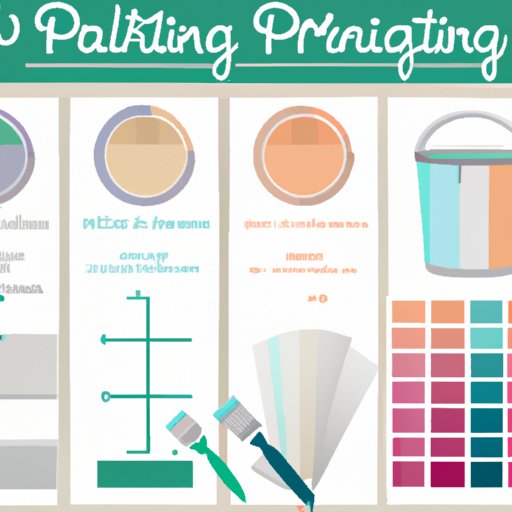Introduction
Interior painting is the process of applying a fresh coat of paint to the walls, ceilings, and trim of a room or house. This can be a great way to bring new life to an old room and make it look like new. But before you start the project, it’s important to understand how much it will cost. In this article, we’ll take a look at the factors that influence the cost of interior painting and provide some tips for saving money.
Calculating the Cost of Interior Painting: A Step-by-Step Guide
Before you can estimate the cost of interior painting, you need to determine the size of the project. Start by measuring the length and width of each wall, ceiling, and trim area you plan to paint. Multiply those dimensions together to get the total square footage. Once you have the total square footage, you can use this number to estimate the cost of materials and labor.
Materials and labor costs vary depending on the type of paint and supplies you choose. The cost of paint itself is usually determined by the number of gallons needed to cover the space. You’ll also need to factor in the cost of primer, tape, drop cloths, brushes, rollers, and other supplies. Labor costs depend on the number of painters and hours needed to finish the job.
In addition to materials and labor costs, there may be additional costs associated with the project. These could include things like furniture moving, wallpaper removal, drywall repair, and more. Be sure to factor these into your budget when estimating the cost of interior painting.

How to Estimate the Cost of an Interior Paint Job
Once you’ve determined the size of the project, it’s time to estimate the cost of materials and labor. Consider the type of paint and supplies you’ll need. For example, if you’re using high-quality paint and supplies, the cost will be higher than if you’re using basic materials. It’s also important to consider the cost of labor. If you’re hiring professional painters, you’ll need to factor in their hourly rate and the number of hours they’ll need to complete the job.

Budgeting for Interior Painting: What You Need to Know
When budgeting for interior painting, it’s important to research local prices. This will give you an idea of what you should expect to pay for materials and labor. You can also compare quotes from different contractors to make sure you’re getting the best deal. Don’t forget to factor in any additional costs such as furniture moving, wallpaper removal, and drywall repair.

The Average Cost of Interior Painting Projects
The average cost of interior painting projects can vary greatly depending on factors such as the size of the project, the type of paint used, and the amount of labor required. Generally speaking, national averages range from $1 to $3 per square foot. However, this can be higher or lower depending on the specific project.
Tips for Saving Money on Interior Painting Costs
There are several ways to save money on interior painting costs. One option is to do the work yourself instead of hiring a professional. This can save you money on labor costs, but be aware that it may take longer and require more effort. Another option is to shop around for materials. You may be able to find better deals on paint and supplies if you take the time to compare prices.
You can also save money by reusing existing paint supplies. If you’re painting over an existing color, you may be able to reuse the same paint and supplies. This can save you money on materials and reduce the amount of time needed for the project.
Determining the Right Amount of Paint for Your Interior
Once you’ve calculated the cost of the project, you need to figure out how much paint you’ll need. Start by measuring the area to be painted. Then, use a paint calculator to determine the number of gallons needed for the job. It’s important to use the right tools and equipment when measuring and calculating the amount of paint you need. This will ensure that you don’t end up spending more money than necessary.
Understanding the Different Types of Interior Paint and Their Prices
There are several types of interior paint available, each with its own advantages and disadvantages. Common types of paint include latex, oil-based, and acrylic. The price of paint can vary greatly depending on the type and brand. Generally speaking, latex paint is the most affordable option while oil-based paint is the most expensive.
Conclusion
Interior painting can be a great way to give your home a fresh new look. To get the best results, it’s important to understand the cost of the project and the different types of paint available. By researching local prices, comparing quotes from contractors, and shopping around for materials, you can save money on your next interior painting project. With the right preparation and planning, you’ll be able to create the perfect look for your home without breaking the bank.


